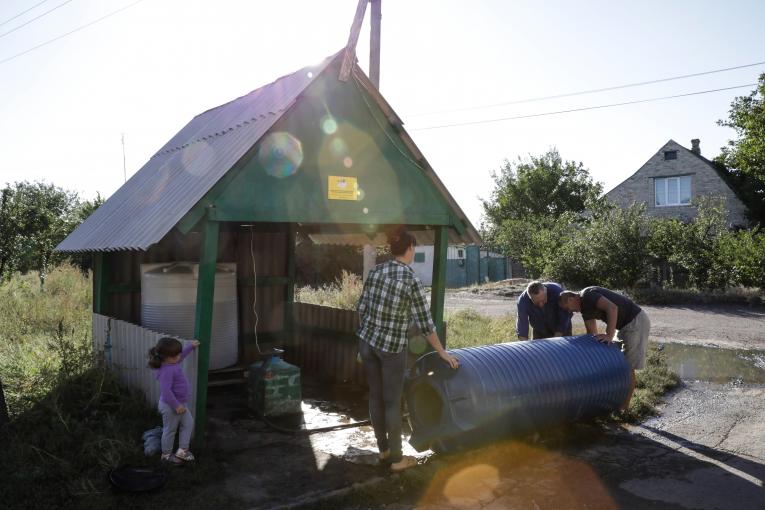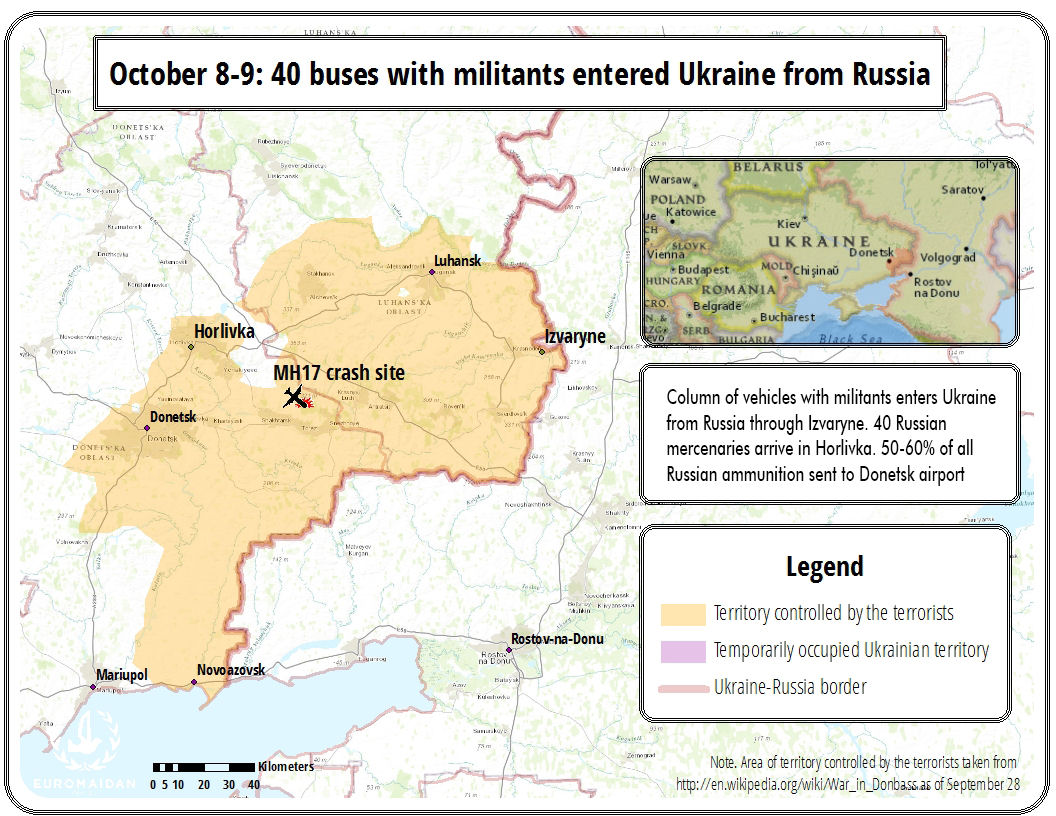The military conflict between Ukraine and combined Russian-separatist forces in Donbas (a region encompassing the Donetsk and Luhansk provinces), which erupted in 2014, has damaged one of the largest water delivery systems in Europe’s East. Water shortages and poor water quality are worsening an already difficult humanitarian, socio-economic and political situation in a war-torn area of Ukraine abutting the frontline territories. Constant shelling threatens access to safe water and sanitation for more than 3.9 million people (including 500,000 children) in eastern Ukraine. Every fourth resident near the contact line lacks a reliable source of drinking water. On September 16, the Verkhovna Rada (parliament) of Ukraine adopted the resolution “On the appeal to the Cabinet of Ministers of Ukraine to take measures to provide the population of Donetsk region with an uninterrupted water supply” (Rada.gov.ua, September 22). But due to the difficult economic situation in the country, it is not quite clear how effective such legislation can be considering the massive financing it would require.
Most of the Donbas region’s water originates from the 300-kilometer Siverskyi Donets–Donbas Canal, which supplies 300 settlements on both sides of the contact line. The canal was built back in 1958, and its associated water supply infrastructure has since almost totally deteriorated. But the main problem is that the waterway is located within the combat zone. Since 2014, the canal, water pipes and pumping stations have been damaged more than 300 times (Novosti.dn.ua, August 31). The northern part of the region relies on the Second Donetsk water supply system. Its length is more than 100 km and provides water to residents of Sloviansk, Kramatorsk, Druzhkovka, Konstantynivka and nearby villages. According to the Municipal Enterprise “Water of Donbas,” which manages the region’s water supply, 100 percent of its pipes are now worn out. Due to water leaks, civilians are experiencing daily or weekly shortages (V-variant.com.ua, June 21).
In addition, armed conflict threatens regional wastewater treatment, which will likely, sooner or later, lead to widespread water pollution and the spread of infections. It is noteworthy that the Donetsk and Luhansk provinces host a concentration of a whole range of potentially dangerous objects, including mines, chemical production entities, industrial facilities and landfills. For instance, Ukraine has a total of 464 tailing dumps (large artificial dams used to store radioactive, toxic, and other waste or by-products after industrial processes) holding 6 billion tons of material; 199 of these tailing dumps are in Donbas. Importantly, many of these objects were built near bodies of water (Rubryka.com, October 28, 2019), so the destruction of or damage to them could lead to a massive ecological disaster. More than 900,000 people live one kilometer away from dangerous industrial sites, most of them found near Donetsk, Makiivka, Horlivka and Toretsk, on the contact line. An investigation by the Donetsk Region Prosecutor’s Office established that, due to the constant damage being done to local critical infrastructure, the ecological balance in the region has been upended. The full extent of the harm done to the potentially hazardous objects in Donbas has yet to be studied; but unquestionably, a further degradation of measures to protect regional toxic and radioactive waste storage facilities could result in the contamination of groundwater, which flows into the Severskyi Donets River and the Sea of Azov. The resulting pollution could perhaps irreparably harm the ecosystem of a massive area (Don.gp.gov.ua, May 21).
Another serious problem—with large-scale environmental and economic implications—is the flooding of mines and discharge of polluted mine water in Donbas. After the beginning of the conflict, the authorities of the so-called Donetsk and Luhansk “people’s republics” (DNR, LNR) closed at least 39 mines and stopped pumping out mine water. The history of coal mining in Donbas goes back over 100 years, during which time, local operators built up a complex drainage system, which is particularly expensive to properly maintain. But the Moscow-backed separatist authorities turned off the pumps and sold them for scrap, allowing many of the mines to thoroughly flood. The water that used to be pumped out to the surface now seeps into numerous hollows. The result is the disappearance of surface water reservoirs previously designated for further industrial use. For example, in Alchevsk, the Isakovsky Reservoir, which was built for the needs of the Alchevsk Iron and Steel Works, has almost completely dried up (Glavcom.ua, July 8). Additionally, contaminated mine water gradually rises to the earth’s surface, comes into contact with regional groundwater and surface water, and contaminates them on both sides of the line of contact (Freeradio.com.ua, May 22). Coal dust, sulfur dioxide, carbon monoxide and nitrogen oxides enter the atmosphere through boiler houses, ventilation shafts, rock heaps and coal depots. Discharged mine water pollutes the environment with suspended solids, affects the mineralization of the soil and spreads toxic heavy metals (Rubryka.com, October 28, 2019). Crucially, such pollution respects no boundaries. Every year, the “Zolote” mine alone dumps 9,300 tons of water laced with sulfur impurities into the Rostov region, across the border. Southern Russia’s granaries use this water for irrigation, and local residents rely on those same sources as well (Spektr.press, October 17, 2019).
Meanwhile, studies suggest that drinking water in Donbas may already be contaminated with radioactive substances from the flooded Yunkom coal mine. In 1979, the site was famously used for a non-military, 0.3-kiloton underground nuclear test, which produced the infamous “Object Klivazh,” a cavernous glass-lined chamber 900 meters below the surface. For 39 years, the radioactive glassy capsule was kept dry. But in April 2018, the DNR authorities turned off the pumps and started to allow Object Klivazh to flood. Reportedly, water carrying low-level radioactive waste has already reached Debaltsevo, Uglegorsk, Zhdanivka and Shakhtarsk (Freeradio.com.ua, July 10).
Until now, the separatist authorities hushed up the issue of water and ecological problems plaguing the DNR-LNR. But in recent months, the situation has become so serious that even the “LNR Ministry of Natural Resources” has admitted that something needs to be done (Lug-info.com, September 21). The difficulty for Kyiv is that the Ukrainian government lacks complete information as to the true ecological situation in the occupied territories. The DNR-LNR authorities blame Ukraine for everything and reject any negotiations on this issue. However, if those environmental safety concerns are not resolved soon, the compounding ecological disaster threatens to affect a vast landmass and potentially millions of people. For now, ordinary Donbas residents are left alone with their problems.
Read More:
- Unprecedented drought hits Russian-occupied Crimea, which can’t overcome water shortage without Ukraine
- The risk of water shortage and implications for Ukraine’s security
- Critical water shortage in Crimea may prompt new Russian attack against Ukraine
- Drought threatens Ukraine, its relations with Russia, and regional cooperation plans
- On the verge of disaster: top 5 environmental problems in Ukraine
- Oksana Zabuzhko: Ukraine is at the forefront of a huge world battle that will transform humanity






